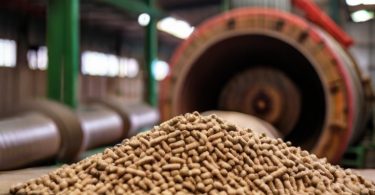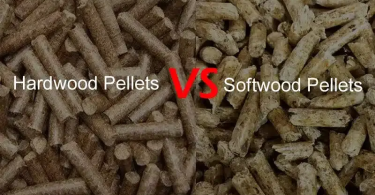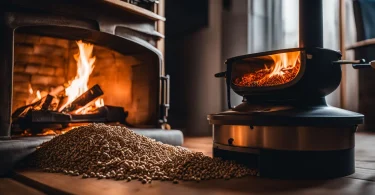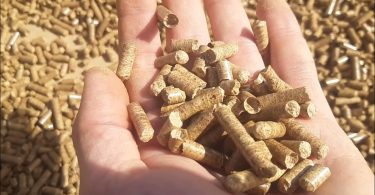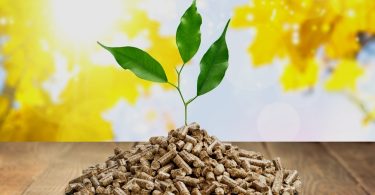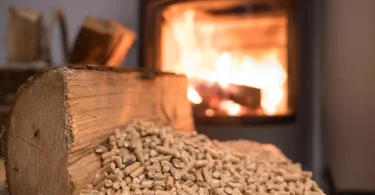- What are Wood Fuel Pellets?
- What are Wood Fuel Briquettes?
- Wood Fuels Advantages and Disadvantages
- * Sustainability
- * Cost
- * Accessibility
- * Convenience
- * Storage
- * Environment
- Wood Pellets vs Briquettes
- Biomass Pelletization
- Biomass Briquetting
- Biomass Binding
- Biomass Pellets vs Briquettes
- Wood Pellets vs Briquettes – Comparison
- 1- Raw Materials
- 2- Pine Wood Pellets
- 3- Paper Pellets
- 4- Straw Pellets
- 5- Grass Pellets
- 6- Caloric Density
- 7- Use
- 8- Stoves
- Are Wood Pellets and Briquettes a More Sustainable Solution?
- Final Thoughts
When looking for ways to heat your home during winter or provide hot water for a larger complex, biomass in the form of palettes and briquettes is the obvious choice. These two wood fuel sources are readily available, can be purchased in most home goods stores and are an obvious competitor to fossil fuels. Still, there is a lot to learn about both pellets and briquettes so let’s go and discuss them in more detail.
What are Wood Fuel Pellets?
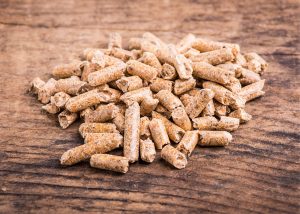
Wood fuel pellets are small cylinders made of biomass or wood that are pressed or extruded by a special machine called a pelleter. This machine can use a variety of finely milled or ground organic fibrous materials as feedstock. The pellets that are extruded are usually between five and ten millimeters in diameter and 2-3 centimeters in length.
What are Wood Fuel Briquettes?
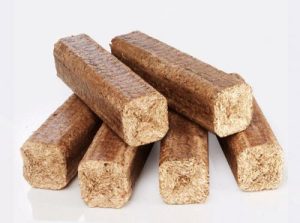
Wood fuel briquettes are bars that are made of organic fibrous materials that are pressed into a cylindrical shape that is 30 to 40 millimeters in diameter and of varying lengths. These bars or cylinders are used instead of firewood in traditional wood stoves. They can be a greener solution than using firewood, especially as they use waste from the wood processing industry that would otherwise be sent to landfills.
Both wood fuel pellets and wood fuel briquettes are sustainable sources of energy that can help your home become a greener home. They can also help economies transition to a more renewable energy. Both of these products are conventionally used and have been so for decades, with prices that are higher than the prices of firewood, but still being able to provide more heat for the same cost.
Wood Fuels Advantages and Disadvantages
When it comes to the type of wood that is used as a fuel source, there is an ongoing debate about the sustainability of these practices. The main concern here is that a lot of wood that is used in making pellets and briquettes is not sustainably sourced. However, with proper practices and with good forest management, it is easy to get feedstock that is sustainable and does not endanger our forests.
One of the biggest advantages that fuel pellets and briquettes offer is the chance to use up the waste from the wood processing industry. A lot of sawdust is produced throughout the world every day, and this sawdust is given a second life instead of being sent to the landfills. Among other advantages of using wood-filled pellets and briquettes are the affordable price, the accessibility of the fuel source, the convenience of use, the convenience of storage and other environmental benefits.
* Sustainability
As wood pellets and wood briquettes allow us to use waste from one industry to generate heat and electricity, the practice of making and using these wood fuels is a very sustainable one. When speaking of sustainability, it is clear that using wood instead of fossil fuels is a greener practice.
What makes it a greener practice is the fact that the carbon that is released during the combustion process is the same carbon that the trees have captured from the atmosphere just years before they were felled. The same cannot be said for fossil fuels as this carbon hasn’t been in the atmospheric cycle for millions of years.
* Cost
Although it is clear that the same volume or tonnage of wood pellets or wood briquettes costs more than the same volume or tonnage in firewood, it is also an undeniable fact that they pack more energy. In fact one metric ton of briquettes can substitute for anywhere between three and four tons of firewood, depending on the type of wood that you use to heat your home. This way, by using pellets and briquettes, the price of heating your home is approximately the same.
* Accessibility
Both briquettes and pellets are readily available in most supermarkets and home goods stores. The same cannot be said for firewood, which has to be ordered usually months in advance. It is this accessibility that makes these fuels so popular. Furthermore, as they are readily available throughout the year, by purchasing them out of season, you can save a lot of money.
* Convenience
The convenience of accessibility is not the only added benefit you can get by using pellets or briquettes. The convenience of use is there as well. Briquettes are much easier and lighter to handle than firewood, and their uniform shape and size allows for easy piling up and storing. When it comes to actually using briquettes instead of firewood, you can use your traditional stove and proceed to use briquettes just as you would firewood.
The same can be said about pellets, which usually come prepacked in plastic bags. Each bag holds anywhere between 15 and 18 kilos of pellets. Pellet stoves have a special storage compartment which can hold the contents of one to two such bags. In most households, it is enough to simply empty 1-2 bags into this storage compartment once a day, depending on your heating needs and the local climate.
* Storage
The ease of storage cannot be stressed enough. Briquettes come in the form of bars or cylinders that are easy to stack one on top of another. They also come in plastic bags, where they have been arranged in such a way that they are easy to pile up. The same is true of pellets. if you order a larger quantity of these they will come on actual palettes that you can simply have dropped in your garage and use them as is needed.
Although both of these products are organic in origin, their low moisture content means they can be kept intact for decades. Normally, both pellets and briquettes will feature moisture content of anywhere between 5 and 10%. For as long as they are kept in their original plastic bags, they should be fine for years to come. However, you should pay attention that there are no critters or other pests in the area where you keep them as they could damage the plastic bags and let humidity in.
* Environment
When it comes to the benefits for the environment, pellets and briquettes differ to an extent. Briquettes burn waste to provide you with heat and in doing so save trees and keep them where they should be – in the forests. They burn more cleanly than wood and produce less ash.
When it comes to wood pellets or biomass pellets they burn even more cleanly. As pellets are burned in special pellet stoves, more heat can be extracted from them and released into your household. This reduces your total need for fuels to keep your home warm. The introduction of fresh, oxygen-rich air several times during the combustion process, less carbon monoxide is formed and even less ash is produced. High quality wood pellets produce less than 2% ash
Wood Pellets vs Briquettes
Wood pellets and briquettes are both premium products, especially if they’re made from virgin raw wood. Using this kind of wood, especially sustainably sourced, is a great way to keep your home warm during winter, with little pollution. These two fuels, when produced out of wood, burn cleanly and provide a lot of energy.
Biomass Pelletization
Biomass pelletization is a process in which very finely ground biomass is extruded and pellets are formed. During this process high temperatures and pressures develop and it is these extremes that enable lignin, normally stored in the wood, to be released. This is a binding agent so no glues of any kind are necessary. This makes pellets very environmentally friendly and cleaner burning.
Biomass Briquetting
When it comes to biomes briquetting, this process is somewhat different to the extrusion that we could see with pellets. The milled feedstock, similar to dough or paste, is mixed with organic or inorganic glues, and is then molded in the shape of bars and bricks, or blocks under huge pressure. After this the briquettes are left to dry. As no high temperatures developed during this process, the external binding agent is needed, making wood briquettes or biomass briquettes a less environmentally friendly solution for heating.
Biomass Binding
So, besides the shape and the size of the two products, it is the way that the biomass is bound, and that makes the biggest difference between pellets and briquettes. In pellets, it is the naturally occurring lignin that acts as the binding agent. In wood briquettes or biomass briquettes, external binding agents need to be introduced. These binding substances are either starches or polyvinyl alcohol.
Biomass Pellets vs Briquettes
Biomass pellets and briquettes can be made out of the same materials. These materials include straw, sawdust, corn stalks, rice husk, peanut shell, crop stock, cotton seed hull and other agricultural waste.
When comparing pellets and briquettes, it is useful to understand that there is a difference in the combustion process itself. They require different types of stoves to be burned in. On top of this, briquettes may burn for a longer time, but you will need to hand refill the stove every time a briquette is almost burned up. The same cannot be said for pellets, which burn faster and can produce more heat in a shorter period of time. On top of this, feeding pellets into the combustion chamber is done automatically.
Wood Pellets vs Briquettes – Comparison
Wood pellets and briquettes are made out of the same type of wood. The wood that is used as feedstock can be softwood or hardwood and it can be sustainably sourced or it can be sourced from waste from the wood processing industry. Old palettes and similar sources are also commonly used.
The biggest difference between the two is that the briquettes demand a form of glue to be used while pellets use lignin that is already present in the wood itself to give them the shape and keep them in that form. Both of these solutions are preferred to using firewood or wood chips, as they can pack more calories and, therefore, more energy in the same volume.
1- Raw Materials
When it comes to the raw materials that are used in the pelletization or briquetting process, you can opt for raw materials of quality that matches the intended use of the heating fuel. The fuel pellets or briquettes can therefore be made using timber, which yields the highest possible quality of the product. However as this can prove to be very expensive, you can also use pellets and briquettes made from other materials, such as wood processing waste, biomass or even agricultural waste. This makes for a product of a lower quality, but also ensures a lower price.
2- Pine Wood Pellets
Pine is a very dry wood. As it contains a low moisture content, this wood takes very little time to dry, and produces both pellets and briquettes of high caloric value. The end product also has a low moisture content and this means that the combustion process is very efficient and that a lot of heat is released.
3- Paper Pellets
Making paper palettes and briquettes is also a possibility. The production process looks almost the same where residues from different Industries are collected and then ground. After this the drying process is necessary, especially if the paper comes from municipal waste. The pelletization process continues as normal and is followed by the cooling phase. The one added step in this process is that of sieving, as paper pellets may not be of a quality comparable to that of wood pellets and may produce more dust.
4- Straw Pellets
Straw pellets are a type of agri-pellets or agro-pellets. These pellets use agricultural waste as their feedstock and there are various sustainable solutions for both heating, animal feeding and even animal bedding. As they expand in size, 1.5 cubic meters of this kind of bedding can expand up to four cubic meters once wet. This type of animal bedding can also be used as cat litter and can be composted once it’s used up.
5- Grass Pellets
Grass pellets are made of grass clippings or hay. They can be used for heating, animal bedding or even cat litter. These pellets are a very sustainable source of both feed and heating energy for as long as the grass used in their making hasn’t been sprayed with any herbicides. As it can be difficult to guarantee the feedstock quality, many farmers rely on their own production facilities of smaller volume to make this kind of pellet.
6- Caloric Density
The caloric density of both wood pellets and wood briquettes is comparable at 4.85 kWh/kg. They mostly differ in the moisture content where the pellets have moisture levels of between 5-10% and briquettes have moisture levels in the range of 6-10%. Although the difference isn’t high, in the long run, pellets can give you more heat and energy with less ash being produced.
7- Use
Pellets have a wider range of use than wood briquettes. Both products can be used to generate heat and electricity in domestic or residential, and industrial scales. On top of this, pellets can also be used as animal feed, animal bedding or even cat litter.
8- Stoves
Another significant difference between these two products is the type of stoves that are necessary to bring them efficiently. Wood briquettes or biomass briquettes demand a traditional wood stove to be burned in. pellets on the other hand need special pellet stoves. Installing one of these also requires access to a power outlet.
How Are Briquettes and Wood Pellets Made?
After the feedstock has been milled and dried, it is sent into an extruder. Within the extruder, there are rollers that apply pressure to the biomass and push it through narrow tunnels, where it is compacted to about 25% of the original volume. As the rollers of the machine apply pressure, a lot of heat is released. The heat further releases lignin from the woody materials and this lignin helps bind the pellets and give them their recognizable shape.
Are Wood Pellets and Briquettes a More Sustainable Solution?
Both wood pellets and briquettes can be a more sustainable solution than simply relying on firewood to keep your house warm. This, of course, depends on the way that the timber is sourced. If the timber comes from sustainably cut forests, the end product will be very sustainable. On top of this a lot of the feedstock material actually comes in the form of a waste from other Industries, mostly from the paper processing, wood processing and agricultural industries.
| Point of Comparison | Pellets | Briquettes |
| Stove Type | Special Pellet-Stove | Traditional Stove |
| Moisture Content | 5-10% | 6-10% |
| Energy Density | 4.85kWh/kg | 4.85kWh/kg |
| Renewable Source | Yes | Yes |
| Uses Additional Glues | No | Yes |
| Can Be Stored For a Long Time | Yes | Yes |
| Purchase Quantity | Single-Pack and Bulk | Single-Pack and Bulk |
Final Thoughts
Both fuel pellets and fuel briquettes are a very sustainable way of heating your home or producing energy for industrial use. As it goes, the technology for producing these two heat sources was meant to utilize waste from various industries, which makes the final product a very sustainable solution that reduces the amount of waste sent to our landfills and the amount of CO2 released from our industries. Today, higher quality products, sourced from sustainable timber are also available and they’re welcomed by more than a million American households.



